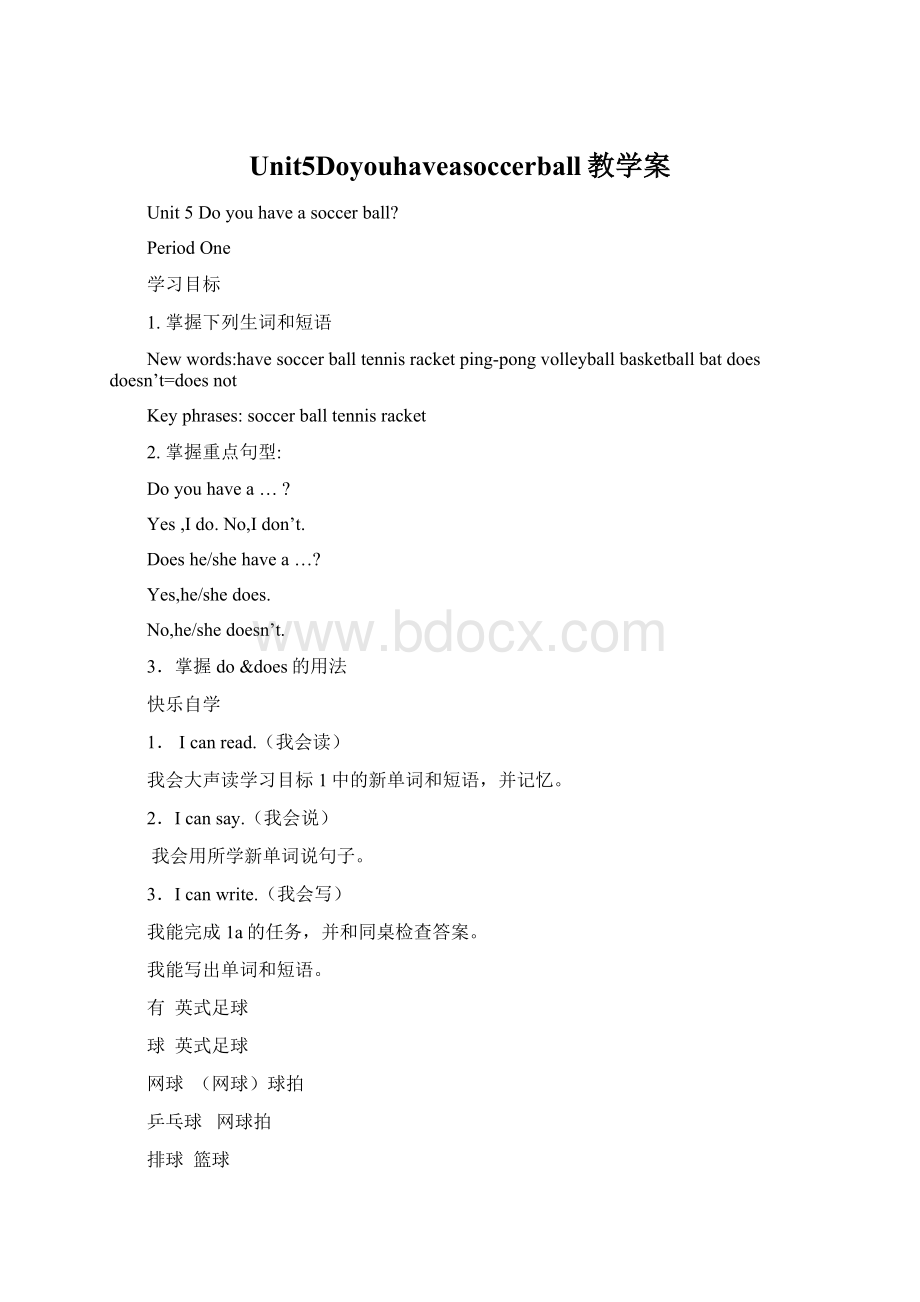Unit5Doyouhaveasoccerball教学案.docx
《Unit5Doyouhaveasoccerball教学案.docx》由会员分享,可在线阅读,更多相关《Unit5Doyouhaveasoccerball教学案.docx(47页珍藏版)》请在冰豆网上搜索。

Unit5Doyouhaveasoccerball教学案
Unit5Doyouhaveasoccerball?
PeriodOne
学习目标
1.掌握下列生词和短语
Newwords:
havesoccerballtennisracketping-pongvolleyballbasketballbatdoesdoesn’t=doesnot
Keyphrases:
soccerballtennisracket
2.掌握重点句型:
Doyouhavea…?
Yes,Ido.No,Idon’t.
Doeshe/shehavea…?
Yes,he/shedoes.
No,he/shedoesn’t.
3.掌握do&does的用法
快乐自学
1.Icanread.(我会读)
我会大声读学习目标1中的新单词和短语,并记忆。
2.Icansay.(我会说)
我会用所学新单词说句子。
3.Icanwrite.(我会写)
我能完成1a的任务,并和同桌检查答案。
我能写出单词和短语。
有英式足球
球英式足球
网球(网球)球拍
乒乓球网球拍
排球篮球
(乒乓)球拍
5.Icanact.(我会表演)
我会和同桌用1a和2c图片中的物品练习类似的对话。
Example:
DoyouhaveaTV?
Yes,Ido.No,Idon’t.
Doeshehaveasoccerball?
Yes,hedoes.No,hedoesn’t.
6.Icanlisten.(我会听)
我会一边听录音,一边完成1b,2a和2b的任务。
7.Icanrecite.(我会)
我会和同桌一起大声GRAMMER中的句子。
合作探究
IamGina.AreyouGina?
Thisismypencil.Isthisyourpencil?
Thesearemybrothers.Aretheseyourbrothers?
Ihaveasoccerball.Doyouhaveasoccerball?
Theyhaveacomputer.Dotheyhaveacomputer?
Hehasatennisracket.Doeshehaveatennisracket?
Shehasasoccerball.Doesshehaveasoccetball?
小组讨论:
含有be动词的句子变一般疑问句时,把放到句首,而含have或has的句子变一般疑问句,要加助动词,其结构为:
助动词+主语++其他?
肯定回答:
Yes,主语+,否定回答:
NO,主语+。
如果主语是第三人称单数(、、等),助动词用。
课堂小结
I’velearnedinthisclass(本节课我学习了):
Words(单词):
Phrases(短语):
Sentences(句子):
达标检测
2.我能连词成句
they,parents,your,are
?
do,have,you,soccer,a,ball
?
he,a,tennis,have,racket,does
?
they,computer,a,do,have
?
a,she,have,does,volleyball
?
3.我能改写句子)
Thesearemynewbooks.
newbooks?
Mysistershaveabasketball.
yoursistersabasketball?
Shehasavolleyball.(变一般疑问句并作否定回答)
sheavolleyball?
she.
学习反思
Unit5Doyouhaveasoccerball?
四川省绵阳市赵学成
Learningobjectives(教学目标)
Skill
Focus
Talkaboutownership.
Makesuggestions.
Listen,describeandtalkaboutinterestsandhobbies.
Learntowriteinreply.
Learntomakesuggestionsusing“Let’s…”
Learntotalkabouthowtospendagreattimewithyourfriends.
Learntowriteaboutsportsthingsandotherthingsyouhave.
Language
Focus
功能句式
Talkaboutownership.(P25)
—Doyouhaveaping–pongball?
—Yes,Ido./No,Idon’t.
Makesuggestions.(P27)
—Let’splaysoccer.
—Idon’thaveasoccerball.
—Well,let’splayvolleyball.
—Itsoundsinteresting/boring/relaxing.
Talkaboutinterestsandhobbies.(P29)
EdSmithhasagreatsportscollection.Hehas8tennisrackets…
词汇
1.重点词汇
have,ball,tennis,ping–pong,volleyball,basketball,let,us,play,well,sound,sport,we,many,club,more,class,interesting,boring,fun,difficult,watch,has,great,but,only,them,every,day
2.认读词汇
soccerball,racket,bat,does,doesn’t,let’s,relaxing,collection
3.词组
soccerball,tennisracket,watchTV,playsports,everyday
语法
ThepresentSimpleTense(have/has…)
Strategy
Focus
1.Guessingbydiscussingwithclassmatesandteachers.
2.Classifyingbywhatyoulearn.
3.Usingwhatyouknow.
Culture
Focus
1.Doyouhaveagreatsportscollection?
2.Howtomakesuggestionspolitely?
Analyzeandrearrangeteachingmaterials(教材分析和重组)
1.教材分析
本单元以“Doyouhaveasoccerball?
”为话题,共设计了三个部分的内容。
SectionA
该部分有4个模块:
第一模块围绕“Doyouhaveasoccerball?
”这一话题展开词汇学(1a)、听力(1b)、口语(1c)训练;第二模块继续围绕“Do/Does…havea…?
”进行听力(2a-2b)、口语训练(2c);第三模块围绕“Makesuggestions.”这一话题展开训练,训练形式为单词填空(3a)和角色表演谈论图画为训练形式(3b);第四模块就“Completetheformsaccordingtothesportsclubyoulike.”以结对活动形式进行介绍。
SectionB
该部分有4个模块:
第一模块是词汇的学习(1a)与运用(1b);第二模块仍然围绕(1a-1b)的词汇进行听力训练(2a-2b)、围绕提建议进行口语训练(2c);第三模块继续围绕“Ownership”这一话题展开有关收藏品阅读(3a),写作训练(3b-3c);第四模块仍就“Ownership”这一话题以口语训练形式展开全班活动。
SelfCheck
该部分有3个模块:
第一模块以填空形式对所学词汇进行训练;第二模块以默写已学过的五个单词的形式对所学的词汇继续巩固复习;第三模块围绕有关ownership和suggestions对话开展口语训练和写作训练。
教材重组和课时分配
Period1(SectionA:
1a,1b,1c)Newfunctionpresenting
Period2(SectionA:
2a,2b,2c,3a,3b,4)Practice
Period3(SectionB:
1a,1b,2a,2b,2c)Vocabularybuilding
Period4(SectionB:
3a,3b,4)Integratingskills
Period5(SelfCheck:
1,2,3&Workbook)Writing
Teachingproceduresandways(教学过程与方式)
PeriodOneNewfunctionpresenting
Languagegoals(语言目标)
1.Words&expressions:
have,soccerball,tennis,racket,tennisracket,ping–pong,volleyball,basketball,bat(P25)
2.Keysentences:
Doyouhaveaping–pongball?
Yes,Ido.No,Idon’t.(P25)
Abilitygoals(能力目标)
Enablethestudentstounderstandandtalkaboutownershipandmakesuggestions.
Emotion&attitudegoals(情感和态度目标)
Enablethestudentstoformpositiveattitudetowardsportscollectionandlovesports,keephealthyandlearntomakesuggestionspolitely.
Strategygoals(策略目标)
Tounderstandthetargetlanguagebyreadingpictures,drawingpictures,counting
numbers,drawingachart.
Cultureawarenessgoals(文化意识目标)
People’sattitudetowardsportscollectionsisdifferentinEnglishspeakingcountries.
Teachingimportantpoints(教学重点)
Talkaboutownershipandmakesuggestions.
Teachingprocedures&ways(教学过程和方式)
Step1.RevisionandLead-in
Askoneormorestudentstoshowtheirhomework.
T:
Inthelastunit,Iaskyoutodoaprojectaboutfillinginthechartbecausewewanttohaveaballgame.Butwedon’tknowwhatkindofballsyouhave.Pleaseaskyourclassmatesinthegroupwhatballshe/shehas.Thenwritedowntheinformationinthechart.Nowwhowantstodisplayyourprojectontheblackboard?
Sampleproject:
Names
Ballsyouhave
WangWei
tennis
LiHong
ping–pong
YangQuan
soccerball
QuZhii
volleyball
LiuFang
basketball
Firstpointtoastudentinthechartwhohastennis.
T:
Doyouhavetennis?
S:
Yes,Ido.
Secondpointtotheothersintheclassroom.
T:
DoesWangWeihavetennis?
S:
Yes,hedoes.
ThirdpointtoLiHongintheclassroomwhohasping–pongball,butnotennis.
T:
Doyouhavetennis?
S:
No,Idon’t.
T:
Doyouhaveaping–pongball?
S:
Yes,Ido.
T:
DoesLiHonghavetennis?
Ss:
No,shedoesn’t.
T:
DoesLiHonghaveaping–pongball?
Ss:
Yes,shedoes.
T:
Todaywearegoingtolearnhowtotalkaboutownershipandmakesuggestions.
Step2.ListingandSpeaking
AskthestudentstoreadthepictureonPage25.
T:
Whatcanyouseeinthepicture?
Ss:
Wecanseeaping–pongball,aping–pongbat,atennisracket,asoccerball,volleyball,abasketball,aTV,acomputergame.
T:
Askthestudentstomatchthewordswiththethingsinthepicture.
Ss:
Say,Number1is(C),tennisracket.Number2is(a),ping–pongball…
Aftercheckingtheanswersin1a,askthestudentstoreadaloudthenewwordsagainandagain,askandanswerabouttheminpairs.Andthenplaytherecordingagain.Thistimestudentslistentoconversationandcirclethewordstheyhear.Andthenchecktheanswers.Studentscircleping–pongbatandcomputergame.
Step3.Pairwork
Askthestudentstoreadtheexampleconversation.Havestudentsrepeat.Andthenpointtothetelevisionintheillustrationandsubstitutethatwordintheconversation.Havestudentsrepeatagain.Andthenaskstudentstopractisetheconversationinpairsandremindthemtousevariousobjectsfromtheillustration.Asstudentspractise,movearoundtheclassroomtocheckprogressandhelpwithpronunciation.
Askformoreideasfromthestudentsandwritetheirideasontheblackboard.
phone,cars,pencilcase,eraser,pen,book,dictionary,watch,key,notebook,ring,sister,brother,chair,bookcase,CD,videotape,hat,desk,dresser…
Showthefollowingtothestudentsandthenaskthemtopractiseinpairs.
—Doyouhaveaphone?
—Yes,Ido.
—DoyouhaveaCD?
—No,Idon’t.
T:
Nowworkinpairs,makeconversationswiththenewwordsin1aandactitoutaroundthestudents.
Sampleconversations:
1.S1:
Doyouhaveaping–pongbat?
S2:
Yes,Ido.
S1:
Doyouhaveaping–pongbat?
S2:
No,Idon’t.
2.S3:
Doyouhavevolleyball?
S4:
Yes,Ido.
S3:
Doyouhaveabasketball?
S4:
No,Idon’t.
3.S5:
Doyouhaveatennisracket?
S6:
Yes,Ido.
S5:
DoyouhaveaTV?
S6:
No,Idon’t.
Step4.Homework
1.Askthestudentstodomorepracticeasrequiredin1conPage25.
2.Askthestudentstopreparethenextperiod.Thinkabouttheusageof“Doesshe/hehave…?
”
PeriodTwoPractice
Languagegoals(语言目标)
1.Words&expressions:
does,doesn’t,let,us,let’s,play,well,sound,good,sport,we,many,club,more,class(P26)
2.Keysentences:
—Let’splayvolleyball.
—Thatsoundsgood.(P26)
Abilitygoals(能力目标)
Enablethestudentstomakesuggestionspolitely.
Emotion&attitudegoals(情感和态度目标)
Trainthestudentstomakesuggestionspolitelyandtakeactivitypartinschool
sportsclubandkeephealthy.
Strategygoals(策略目标)
Enablethestudentstomatchtheproblemsandworries.
Cultureawarenessgoals(文化意识目标)
Learntohowtomakesuggestionspolitely.
Teachingimportantpoints(教学重点)
Talkaboutmakingsuggestions.
Teachingprocedures&ways(教学过程和方式)
Step1.Revision
Beforeclass,let’shavearevision.Firstmakeupaconversationwith“Doyouhave…?
”aboutownership,andtheninthreesmakeupaconversationwith“Doyouhave…?
Doesshe/hehave…?
”
Sampledialogues:
1.S1:
Doyouhaveasoccerball?
S2:
Yes,Ido.
S1:
Doyouhaveabasketball?
S2:
No,Idon’t.
2.S1:
Doyouhaveacomputergame?
S2:
No,Idon’t.
S1:
Doyouhaveaping–pongbat?
S2:
Yes,Ido.
S3:
Doeshehaveacomputergame?
S1:
No,hedoesn’t.
S3:
Doeshehaveaping–pongbat?
S1:
Yes,hedoes.
Step2.ListeningPractice
Playtherecordingforthefirsttime.
T:
Listentothetape.Youonlylisten.
Playtherecordingforthesecondtime.Thenchecktheanswers.
T:
You’llhearthesameconversationagaininthepicture.Thistimepleaselisten